Whatever Happened to Representational Art?
Until very recently, artists earned their bread and butter by painting "pretty good" poster-sized portraits of rich people; if they were lucky they might have been commissioned to do something in a religious vein, but that is where most artistic creativity stopped. Then the photograph came along and changed art forever. The photograph's ability to re-present better, faster, and cheaper than any artist had a dramatic effect on art.
The history of the development of the photograph includes two milestones. In 1814, Joseph Nicéphore Niépce achieved the first photographic image with his "camera obscura"—however, the image required eight hours of light exposure and later faded. In 1837, Louis-Jacques-Mandé Daguerre invented the "daguerreotype," which was the first image that was fixed and did not fade and needed under thirty minutes of light exposure. The daguerreotype gained popularity quickly; by 1850, there were over seventy daguerreotype studios in New York City alone. The effect on the art world occurred concomitantly with the spread of easy re-presentation.
To stay in business, artists had to reinvent art and explore new opportunities. They did so mostly by calling their own and each other's strange, deviant, or even ugly renderings "significant" or "wonderful." In painting, Impressionism emerged with Claude Monet and others in Paris in the 1860's. Cubism emerged in the early 20th century starting with Pablo Picasso, Georges Braque, and Juan Gris. Dada also emerged in the early part of the 20th century. According to its proponents, Dada was not art, it was "anti-art." Also early in the 20th century, Wassily Kandinsky started painting the first modern abstract works. Surrealist thoughts emerged around 1920, partly as an outgrowth of Dada, with French writer André Breton as its initial principal theorist, and Salvador Dalí was one of the early painters. Surrealist thought also connects with the theories of psychiatrist Sigmund Freud. M. C. Escher was a graphic artist known for his often mathematically inspired woodcuts, lithographs, and mezzotints which feature impossible constructions, explorations of infinity, and tessellations. Pop art emerged in the early 1950's. Minimalism in visual art, sometimes referred to as "literalism" and "ABC Art," emerged in New York in the 1960s. The point being that all of these works were of a type and kind that a camera cannot produce.
Here are but three paintings from the early part of the twentieth century to illustrate the transition:
 |
--> |  |
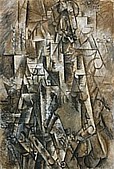 |
|
Pablo Picasso |
|
Marcel Duchamp |
Pablo Picasso |
None of these pictures are quite like what a camera would have rendered, but the transition/liberation from representational art is exemplified.
With the long view now (say, over the last 200 years), we can see that the photograph had the effect of blasting art apart—possibilities spiraled off in all directions. A stone was thrown into the relatively-still pond of art, making waves. (The "wave-particle nature of historical revisionism.") Psychology was emphasized with impressionism and many of the types of art that followed, the post-structural and post-modern movements emerged, and we are still reeling from the effects of the one invention: the photograph.
(Some photographs are themselves considered to be art (rather than snapshots, mere representations, or almost-art) because of their composition, texture, and perspective, but that is a tangential subject for us here.)
With this in mind, the following describes yet another direction: in this case, in the direction of almost-art.
Introducing Re-Non-Representational Art
The pictures in the Re-Non-Representative exhibits represent a new genre, even kingdom, of art known as Re-Non-Representational art (or "Re-Non-Re," or just "Re-Non" art, for short). They represent re-non-representationalism, if you will. With re-non-representative art, the beauty, the image of the re-presented exists only in the mind of the beholder. The image can change from viewing to viewing, or from moment to moment with shifting mental considerations.
It is not that these kinds of displays are not already everywhere around, it is just that this might be the first time anyone has put a name to it. As children we all saw the block with the letter “M” on it, then looked up and saw Mama, and related the two. The idea is the same. Until now, re-non-re art has been lurking amidst the plethora of almost-art that goes by unnoticed, . . . and unsung.
With so-called traditional “representational art,” the picture
that looks like a rich guy, a bear, or a bunch of trees represents the
dude, the animal, or the landscape in appearance: that is, there is a visual
likeness. If there is only one head in real life, then there is only one head
re-presented. Re-non-representational art is, at first glance, non-representational.
Re-non-representational art is that type of non-representational art that "again
represents," and it does so with the help of a description that helps with
the identification of the represented. (Again, as the name might suggest, non-representational
art is art that does not represent its object in the similarity of appearance.) 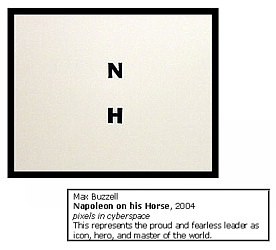
To give this a name, a “re” is therefore added to the beginning of “non-representational” to indicate that it really does represent the object, it is just that it rightly belongs to the subset of everything that is "nonrepresentative through appearance."
Unlike most art, though, as a sign, almost all of what is conveyed comes from the description on the plaque, and the symbols within the frame are merely placeholders. In this sense the total package is very much representational, but also simple in its conveyance. But because there is no artistic refinement, re-non-representational art cannot rightly be considered art, but only almost-art. A few words on a placque are not by themselves fully art, the symbols in the frame are not, and neither does merely framing something make it fully art.
There is virtually no formal value (see the Aspects section) in the framed portion. It draws on extra-formal value (provided by the social context) that is beyond the control of the artist—relevant ideas emanating from sources distant to the art-object. The trace and the signage are dynamic, again, not between the object and the observer, but between the object, the description of the object, and the observer. The picture itself is not so much a reflection of a sign system as it is an origination point for an adventure in thought and imagination (an aspect it shares with other types of art).
Said a slightly different way, almost all of what is communicated to the observer about re-non art arrives via "society-in-general" (by way of experience, and values and ideas related to art), rather than it transferring directly from the artist to the observer via the art-object. The observer's experience of the art-object is merely suggested by the "artist."
Like a picture of a bowl of fruit, or a landscape with a house in the middle of the picture, a picture of Napoleon on his horse could have been depicted in many different ways: "*/$," "H/N," or " X/Y" (as depicted here).

Our mental image could be:
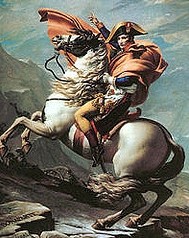
or
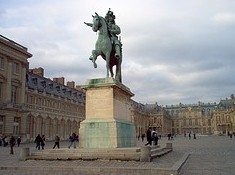
or
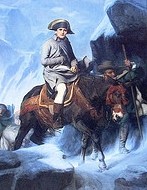
or
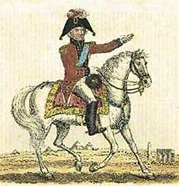
depending on which image is re-membered (or we may have imagined something different all by ourselves).
How Re-Non-Representational Art is Artistic
The following chart can be considered an extension of the "Reasons" chart on the Reasons page:
| Reasons Why Re-Non-Re Might Be Almost-Art | ||
|---|---|---|
| Code | Reason | Considering Re-Non-Re |
| AAR-1 | The object being considered is only part of an art-object, and not enough to be considered art by itself. | The examples here are complete works and not parts of works. |
| AAR-2 | The object being considered as an art-object is unfinished (or perhaps, partially destroyed). | The examples here are considered to be completely and fully rendered by their creator. |
| AAR-3 | The object being considered is too juvenile/primitive/crude, even though there was obviously some attempt at symbolism, estheticism, symmetry, proportion, composition, harmony, etc. | Check. But the examples here are no more juvenile than most minimalist or conceptual art. |
| AAR-4 | The object being considered is more a phenomenon of Nature than an artifice of man. | The examples here are man-made. |
| AAR-5 | The zeitgeist (or an ideology, or a society) considers the object to be almost-art rather than art or non-art (even though earlier the object may have been considered art or non-art). | Most would probably consider these works to be almost-art rather than art. |
| AAR-6 | The functional or useful aspects of the object so overwhelm the perception and consideration of the object as an art-object that it is not commonly deemed to be at the level of art. | The objects here are all quite useless. |
| AAR-7 | There was no attempt on the part of the artificer to make the object something to be admired as art, and it shows; but still the observer might admires some aspect of what he sees (maybe even inadvertently, temporarily, or unwittingly). | The mental image one gets from the examples here are meant to be admired intently (of course), but the artificer recognizes the difference between "N/H" and a statue or painting of Napoleon on his horse. |
| AAR-8 | The import/significance of the art is negligible. The art-object is low in artistic value (simple, or with little formal value). | Check. The examples here are even simpler than Matisse's "cut outs," but they do have some significance. |
As was done with other examples on the Reasons page, the score for the above categories for the "N/H" depiction of Napoleon on his Horse (or other re-non-re works) would be as follows: 10, 10, 2, 10, 4, 10, 3, 3. The average score is 6.5. The median score is 7. The highest score is 10. The lowest score is 2.
(Therefore, in the Exhibits, they get a "failing grade" for AAR-3, AAR-5, AAR-7, AAR-8.) (Note: there is no such thing as "failing" in art, just qualifying or not under particular definitions.)
For just one more comparison (you may wish to try this for other things yourself), here are the scores that I would give a well made martini: 10, 10, 4, 8, 4, 3, 3, 2. The average score is 5.5. The median score is 4. The highest score is 10. The lowest score is 2.
Why Re-Non-Representational Art is not Minimalist Art
Minimalist art still represents, just minimally; or if it is abstract minimalist art it minimally conveys an abstraction or feeling or notion. This is a question of degree, and while there is a symbol being used with re-non-re, it is not representative (that is, any non-representative symbol may be used within the frame).
Re-non-re almost-art does not join with Minimalism as a deliberate search for the simplest form of expression of an idea, but rather, it make sure the idea is not represented at all, . . . and then tells you that it is.
Once minimalist art becomes so minimal that it conveys nothing but arbitrary symbol it becomes nonrepresentative. At that point it may be assigned a meaning, and this is exactly what re-non-representative art is.
Note: All art benefits from the information supplied on its associated plaque: Michaelangelo's David would just be a sculpture made by somebody of a human form otherwise.
Crucial to the Minimalist conception is that there is not only a minimal amount of visual information conveyed, but also a minimal amount of communication, period. Crucial to the Re-Non-Re-presentation idea is that a lot of information and often complex considerations are conveyed.
Why Re-Non-Representational Art is not Conceptual Art
Conceptual art does not attempt to remove the object's representational aspects, but instead focuses on something else: the concepts conveyed by the object. (Conceptual art tries to reach beyond portraiture, or still life, or landscape painting, even though it may contain images of things, and tries to convey something abstract. As such, in part, the "conceptual" aspect suffuses every form of art, it is just that the concepts are the central focus with conceptual art).
Conceptual art relays a concept that is other than that of a thing represented; a re-non-representational work may also do that, but not before removing representation.
Why Re-Non-Representational Art is not Abstract Art
Re-non-representational art is not "abstract art," "non-objective art," or even "subjective art." These terms all refer to more than what is being described here as re-non-representational. There is no essence or notion being extracted from something, and no play on feelings. There is no esoteric subtlety, or impression, being communicated (by the image alone); neither is this new brand of art difficult to understand, abstruse, disassociative, summarizing, provocative, contingent, or inherently vague.
Like most art-objects, abstract art objects are typically accompanied by a plaque (or title or inscription), but the relaying of the abstract information is attempted with and by whatever goes inside the frame.
Re-non-re may relay abstract ideas and not just mental images of things, but the framed image is not relied upon to do that.

